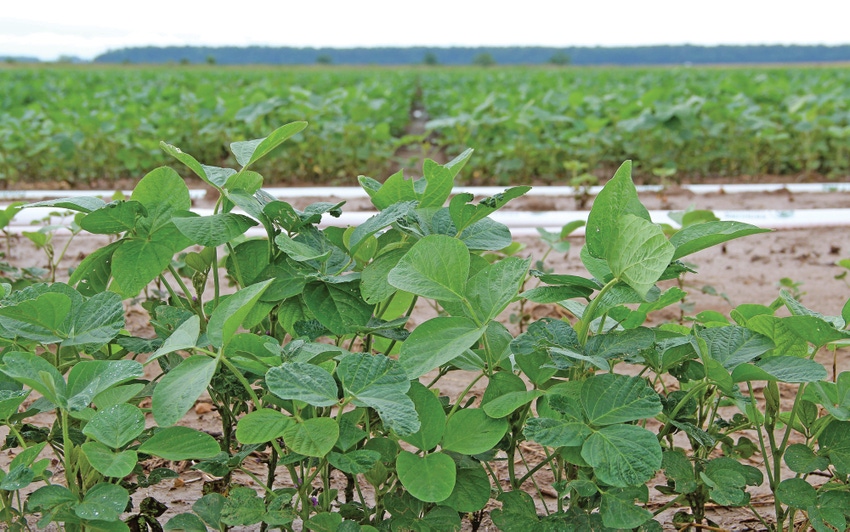July 5, 2012

Unprecedented drought in Oklahoma and Texas and extreme heat and dry conditions in the Southeast made 2011 a challenging year for peanut producers, but the Peanut Profitability Award winners somehow found a way to persevere and achieve excellence on their respective farms.
“This past year was the most variable crop year we’ve seen,” says Marshall Lamb, research director for the National Peanut Research Laboratory in Dawson, Ga., and advisor for the Farm Press Peanut Profitability Awards.
Impressive yields
“But there were areas, especially in the Southeast, where growers received timely rainfall, and the result was some very impressive yields. Our award winners this year showed incredible resilience in the face of difficult conditions.”
While improved peanut varieties continue to help boost average yields, they’re not automatic, says Lamb.
“New varieties and genetics are very important and undoubtedly have contributed to our production, but our Peanut Profitability Award winners also practiced cutting-edge management techniques on their farms, and that’s why they’re being honored for their 2011 production,” he says.
Despite having two devastatingly dry years in 2010 and 2011, it looks as though peanut producers may have reached a new plateau in yields, says Lamb, with an average of about 3,300 pounds per acre during the past four years.
In the face of drought conditions, a couple of states boasted record peanut yields this past year. Florida tied its record average yield from the previous year and Mississippi had a 4,000-pound yield. Georgia’s yield was adjusted up to 3,520, with some growers reporting 6,000 and 7,000-pound yields.
The U.S. average peanut yield in 2011 was basically the same as in 2010, at 3,300 pounds per acre.
U.S. record yield in 2008
The U.S. record average peanut yield was set in 2008, at 3,426 pounds per acre, and in 2009, it was close to that record yield.
Over the last four to five years, the United States has been above 3,000 pounds per acre, and the trend has been about 3,350.
Acreage, on the other hand, has responded to market conditions, with boom and bust-type cycles. This past year, U.S. peanut acreage was pegged at 1.141 million.
This marks the first time in the history of the Peanut Profitability Award that winners have been selected from the states of Florida and Oklahoma, says Lamb.
The winning growers will be honored during the 14th annual Southern Peanut Growers Conference at the Edgewater Beach Resort in Panama City, Fla., July 19-21.
Each of this year’s winning growers represents one of the three major U.S. peanut production regions — the Southwest Region, the Upper Southeast Region and the Lower Southeast Region. Farm Press established the awards program in cooperation with the Southern Peanut Growers Conference and the Southern Peanut Farmers Federation.
Award winners listed
This year’s honorees include:
Southwest Region — Joe D. White, Tillman County, Oklahoma.
Lower Southeast Region — I.C. Terry Farms, Lake City, Fla.
Upper Southeast Region — Bud Bowers, Luray, S.C.
“Our Lower Southeast winners – the Terry’s – are unique in that their production is all dryland, in a bahia grass rotation system they’ve perfected over many years.
“Our Southwest winner does an excellent job of managing fixed costs, which is an important component of the award criteria. His equipment costs are very low, and he also does an excellent job of marketing his crop.
“Our Upper Southeast winner is one of the most innovative producers I’ve seen in the program. He shows amazing flexibility in his management skills, using a field-specific mentality,” says Lamb.
The Peanut Profitability Award isn’t simply a “top yield” prize, stresses Greg Frey, publisher of Farm Press Publications.
“The distinction of being named a Peanut Profitability winner is reserved only for those producers who balance production costs with excellent yields and quality, across their entire peanut production system,” says Frey.
“Our winners this year — just as in years past — controlled costs while maximizing yields and profits. It’s not easy to achieve such a balance, and that’s why we feel it’s important to recognize those who accomplish it,” he says.
But recognizing deserving growers isn’t the only aim of the Peanut Profitability Program, says Frey.
“Education is an equally important component of the program. There’s much to learn about successful peanut production, and Farm Press helps to make this information available by publishing numerous articles throughout the year focusing on maintaining high yields and efficiency. Growers also will benefit from reading about the production practices of this year’s award winners.”
Peanut lab evaluates entries
Lamb and his staff at the National Peanut Research Laboratory evaluate entries each year for the Peanut Profitability Award. Lamb designed the nomination form that is used by growers in determining production efficiency.
The Peanut Profitability Awards, explains Lamb, are based solely on production efficiency — honoring those growers who produce the highest yields at the lowest cost per acre. The awards are based on a producer’s entire farm operation, and not just on individual farms or small plots.
Lamb explains that profit is a function of three equally important factors — yield, price and cost.
“More importantly, this program helps other farmers learn from what our winning producers did so they can improve their individual operations. In addition to being a recognition program, it’s also an excellent educational program.”
For more information on this year’s winners and their production practices, see the articles in the July 6, 2012, issue of Delta Farm Press.
Sponsors of this year’s awards include AMVAC Chemical Corporation; Arysta LifeScience; Becker Underwood; DuPont Crop Protection; Golden Peanut Company; Helena Chemical Company; INTX Microbials, LLC; Rio Tinto Minerals; Syngenta Crop Protection; National Peanut Board; Southeast Farm Press; Delta Farm Press; and Southwest Farm Press.
About the Author(s)
You May Also Like




